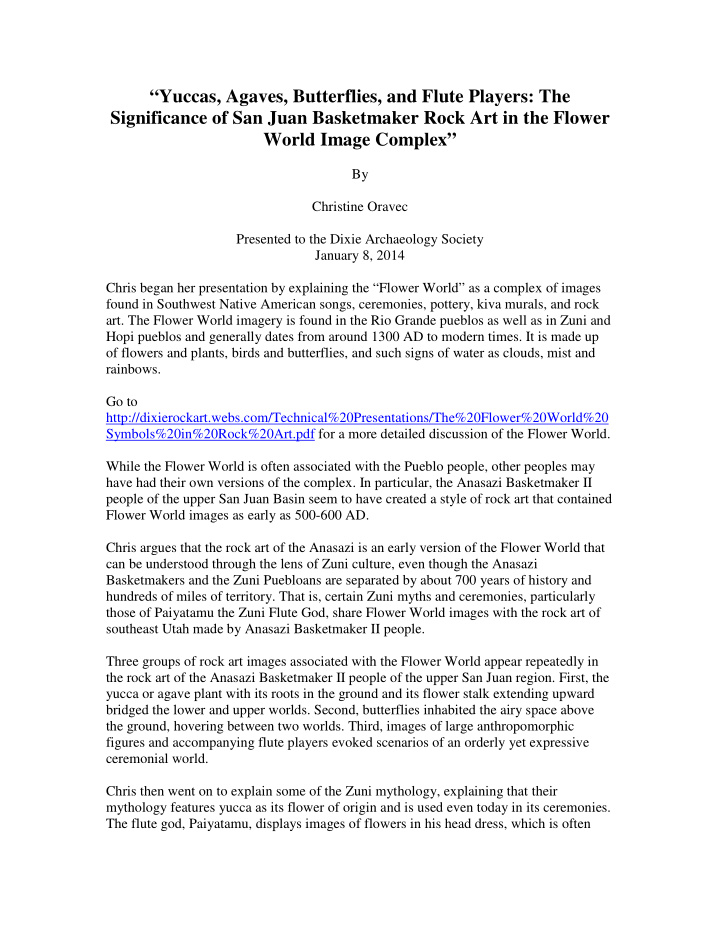



“Yuccas, Agaves, Butterflies, and Flute Players: The Significance of San Juan Basketmaker Rock Art in the Flower World Image Complex” By Christine Oravec Presented to the Dixie Archaeology Society January 8, 2014 Chris began her presentation by explaining the “Flower World” as a complex of images found in Southwest Native American songs, ceremonies, pottery, kiva murals, and rock art. The Flower World imagery is found in the Rio Grande pueblos as well as in Zuni and Hopi pueblos and generally dates from around 1300 AD to modern times. It is made up of flowers and plants, birds and butterflies, and such signs of water as clouds, mist and rainbows. Go to http://dixierockart.webs.com/Technical%20Presentations/The%20Flower%20World%20 Symbols%20in%20Rock%20Art.pdf for a more detailed discussion of the Flower World. While the Flower World is often associated with the Pueblo people, other peoples may have had their own versions of the complex. In particular, the Anasazi Basketmaker II people of the upper San Juan Basin seem to have created a style of rock art that contained Flower World images as early as 500-600 AD. Chris argues that the rock art of the Anasazi is an early version of the Flower World that can be understood through the lens of Zuni culture, even though the Anasazi Basketmakers and the Zuni Puebloans are separated by about 700 years of history and hundreds of miles of territory. That is, certain Zuni myths and ceremonies, particularly those of Paiyatamu the Zuni Flute God, share Flower World images with the rock art of southeast Utah made by Anasazi Basketmaker II people. Three groups of rock art images associated with the Flower World appear repeatedly in the rock art of the Anasazi Basketmaker II people of the upper San Juan region. First, the yucca or agave plant with its roots in the ground and its flower stalk extending upward bridged the lower and upper worlds. Second, butterflies inhabited the airy space above the ground, hovering between two worlds. Third, images of large anthropomorphic figures and accompanying flute players evoked scenarios of an orderly yet expressive ceremonial world. Chris then went on to explain some of the Zuni mythology, explaining that their mythology features yucca as its flower of origin and is used even today in its ceremonies. The flute god, Paiyatamu, displays images of flowers in his head dress, which is often
made of yucca. Other legends say that Paiyatamu used his flute and the butterfly to help transform maidens from girls into young women. This imagery is used today in the “ceremonies of the butterflies”. Paiyatamu also used his flute music for the purposes of life, growth and celebration. The "Butterfly Dance" from J Walter Fewkes 1910, "The Butterfly in Hopi Myth and Ritual" Chris then showed numerous examples of rock art from the San Juan basin that show the various flower world symbols – yucca and agave plants, butterflies, flute players and large anthros that have these symbols incorporated into their images, especially their head dresses. She showed images from Montezuma Creek, Comb Wash, Butler Wash, Sand Island, Grand Gulch and others. Some well known panels that illustrate her points are the “Big Man Panel” and the “Wolf Man Panel”. The “Big Man” Panel
The “Wolf Man” Panel (left side and right side) Butler Wash Panel Chris concludes that the social organization and spiritual world view of both the Basketmaker and Puebloan peoples may be surmised through close examination of the signification and context of the Flower World complex of imagery, as expressed in myths, ceremonies, and rock art. In particular, the San Juan Basketmaker regional variation of the Flower World image complex might have functioned to maintain group identity and to reinforce a commonly shared world view. She further explains that in our attempts to understand Basketmaker peoples through their rock art, our recognition of the world view implied by the Flower World complex may be very important. Central to the shared experience of Anasazi and Puebloan people was a basic belief in a spiritual domain that achieved eternal presence by transcending time and space. Since the image complex of the Flower World reproduced both the living present and the timelessness of eternity, it may have been particularly well suited to the spiritual requirements of ceremonies celebrating the upper and lower worlds. Indeed, the image complex of the Flower World might have been a primary expression of ancient and contemporary Southwestern Native American cosmology. In this sense, the Flower World may be not only significant but essential to our understanding of ancient and contemporary Native Americans’ experience.
Finally, the Flower World complex of images enriches our study of rock art located in the upper San Juan River Basin as seen through Zuni mythology and ceremony. We may also learn that the cultures that produced these images transmitted to us part of what the people deemed important--their enthusiasms, their memories, and their shared experiences. Chris presented this paper at the URARA Symposium in October 2013 and it will be published in the proceedings of the symposium. Chris Oravec and John Mangels
Recommend
More recommend